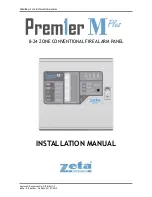
PREMIER M PLUS INSTALLATION MANUAL
Approved Document No: GLT.MAN-111
PAGE
6
Issue : 2.8 Author: NJ Date: 23/07/2012
Old Manual call points, which just cause a short circuit, are not
directly compatible, as they would cause a short circuit fault.
Fitting a 470R resistor in line with the call point will allow it to
work.
(Note: if this is the last device, the end of line (+ve) will connect to
the connector block, NOT the call point)
Other makes of detector will have different connections, but in general they are wired in one of 2 ways:
SPLIT NEGATIVE
+IN
&
+OUT
to same terminal,
-IN
to stripe side of continuity diode,
-OUT
to non-stripe side of continuity diode.
Or
SPLIT POSITIVE
+IN
to non-stripe side of continuity diode,
+OUT
to stripe side of continuity diode,
-IN
&
-OUT
to same terminal.
Some makes of detector will connect the +ve to a 470R load resistor, or a polarisation diode, to enable the detector to work
correctly with European Fire Alarm Panels.
For more specific device wiring information, please refer to the device manufacturers' own instructions.
The termination of each detection circuit must be as indicated on the main PCB (See page 15). The Earthing of the cable screens
should be as shown on page 9.
3.4 SOUNDER CIRCUIT WIRING DIAGRAM
Note: If non-polarised alarm devices (e.g. some types of old mechanical bell, or a relay) are used, then a diode will have to be placed
in line with the device to enable fault monitoring. They may also need a back EMF protection diode. (symptoms: Chattering sounder
relays that don’t turn off).
3.5 AUXILIARY OUTPUT WIRING
3.5.1 Auxiliary Fire Output (AUX):
Voltage free changeover contacts. Changes over in any fire condition, and is used for driving local fire fighting equipment such as
sprinkler systems, magnetic door holders, air conditioning shut off, etc.


























